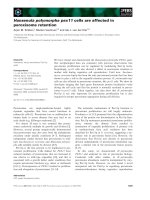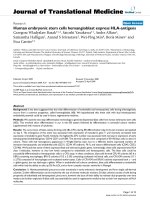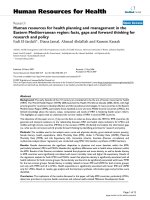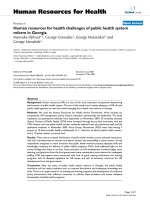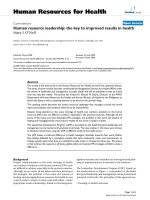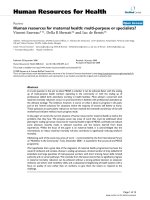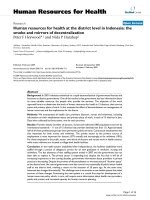Báo cáo sinh học: "Human cytokine-induced killer cells have enhanced in vitro cytolytic activity via non-viral interleukin-2 gene transfer" docx
Bạn đang xem bản rút gọn của tài liệu. Xem và tải ngay bản đầy đủ của tài liệu tại đây (262.22 KB, 6 trang )
BioMed Central
Page 1 of 6
(page number not for citation purposes)
Genetic Vaccines and Therapy
Open Access
Short paper
Human cytokine-induced killer cells have enhanced in vitro cytolytic
activity via non-viral interleukin-2 gene transfer
Srinivas Nagaraj
†
, Carsten Ziske
†
and Ingo GH Schmidt-Wolf*
Address: Department of Internal Medicine I, General Internal Medicine Rheinische Friedrich-Wilhelms-Universität, Bonn, Germany
Email: Srinivas Nagaraj - ; Carsten Ziske - ; Ingo GH Schmidt-Wolf* - Ingo.Schmidt-
* Corresponding author †Equal contributors
IL-2gene therapydendritic cellsCIK
Abstract
Modulation of the immune system by genetically modified immunological effector cells is of
potential therapeutic value in the treatment of malignancies. Interleukin-2 (IL-2) is a crucial cytokine
which induces potent antitumor response. Cytokine-induced killer cells (CIK) have been described
as highly efficient cytotoxic effector cells capable of lysing tumor cell targets and are capable of
recognizing these cells in a non-MHC restricted fashion. Dendritic cells (DC) are the major antigen
presenting cells. This study evaluated the antitumor effect of CIK cells which were non-virally
transfected with IL-2 and co-cultured with pulsed and unpulsed DC. Human CIK cells generated
from peripheral blood were transfected in vitro with plasmid encoding for the human IL-2.
Transfection involved a combination of electrical parameters and a specific solution to deliver
plasmid directly to the cell nucleus by using the Nucleofector
®
electroporation system.
Nucleofection resulted in the production of IL-2 with a mean of 478.5 pg/10
6
cells (range of 107.6–
1079.3 pg /10
6
cells/24 h) compared to mock transfected CIK cells (31 pg/10
6
cells) (P = 0.05). After
co-culturing with DC their functional ability was assessed in vitro by a cytotoxicity assay. On
comparison with non-transfected CIK cells co-cultured with DCs (36.5 ± 5.3 %), transfected CIK
cells co-cultured with DC had a significantly higher lytic activity of 58.5 ± 3.2% (P = 0.03) against
Dan G cells, a human pancreatic carcinoma cell line.
Introduction
Advances in the characterization of cytokines and tumor
antigens, coupled with our increasing ability to manipu-
late gene expression, have fostered a new era of tumor
immunotherapy [1]. Interleukin-2 (IL-2) affects a variety
of components of the cellular immune system, including
B cells and macrophages by inducing the secretion of
tumor necrosis factors (TNF) α and β and interferon-γ.
Mainly, IL-2 is responsible for the proliferation of T cells.
In animal and some human studies, systemic administra-
tion of IL-2 has antitumor effects, mediated by cytotoxic
effector cells (such as lymphokine-activated killer – LAK
cells and cytotoxic T lymphocytes) [2]. Such systemic
administration often induces high toxicity and is shown
to be inferior to local continuous production of cytokine,
for recruitment of T cells [3]. Cytokine-induced killer cells
(CIK) are non-major histocompatibility complex-
restricted cytotoxic lymphocytes generated by incubation
Published: 25 August 2004
Genetic Vaccines and Therapy 2004, 2:12 doi:10.1186/1479-0556-2-12
Received: 11 February 2004
Accepted: 25 August 2004
This article is available from: />© 2004 Nagaraj et al; licensee BioMed Central Ltd.
This is an open-access article distributed under the terms of the Creative Commons Attribution License ( />),
which permits unrestricted use, distribution, and reproduction in any medium, provided the original work is properly cited.
Genetic Vaccines and Therapy 2004, 2:12 />Page 2 of 6
(page number not for citation purposes)
of peripheral blood lymphocytes with anti-CD3 mono-
clonal antibody, interleukin (IL)-2, IL-1 and interferon
gamma (IFN-γ). CIK represent cells with high antitumor
cytotoxicity in vitro and in vivo [4]. CIK cells possess
enhanced cytotoxic activity as compared to standard lym-
phokine activated killer (LAK) cells [5,6]. CIK cells,
express CD4 (45.4+/-3.2) % and CD8(47.7+/-11.0%)
markers. It has been shown that NKT cells co-expressing
CD3 and CD56 markers on their surface represent the
major cytotoxic subset of CIK cells [7]. These NKT cells are
derived from T cells [5]. Because of the increase in cytotox-
icity and high proliferative response, CIK cells have a 73-
fold increase in total lytic units per culture as compared to
IL-2-stimulated LAK cells. Gene transfers of cytokine
genes to CIK and tumor cells have been extensively stud-
ied. CIK cells transfected with cytokine genes have shown
to induce antitumor effects [8].
Dendritic cells (DC) are specialized antigen-presenting
cells located throughout the human body. They represent
heterogeneous cell population, residing in most periph-
eral tissues where they represent 1–2% of the cell num-
bers. In the absence of ongoing inflammatory and
immune responses, dendritic cells constitutively patrol
through the blood, peripheral tissues, lymph and second-
ary lymphoid organs [9]. Morphologically, mature DC are
large cells with elongated and stellated processes. They
express high levels of MHC I and II, CD11 a, b, c, CD40,
CD54, CD58, CD80, CD83, CD86. The most typical
markers at present are MHC I, II and co-stimulatory mark-
ers such as CD80, CD86, [10] which present signals to
CD4 and CD8 positive T cells. Once T cells are activated
after interaction with a DC exhibiting the appropriate
tumor-associated peptide antigen and class I molecule,
they kill other cells that express these molecules such as
tumor cells.
Exocrine pancreatic carcinomas have a very poor progno-
sis and a resistance to conventional therapy. This is mainly
induced by lack of immuno-competent cells. Therefore, it
might be beneficial for patients with pancreatic cancer to
induce an immune attack against the tumor by inserting a
cytokine gene into the immunological effector cells. The
aim of this study was to evaluate the antitumor immune
responses of a cytokine immunotherapy using gene trans-
fer to provide continuous and local cytokine production
and therefore showing an improved cytotoxic effect
against pancreatic cancer cells.
Material and methods
Generation of dendritic cells
DC were generated as described before [4,7]. Blood was
drawn according to our protocol accepted by the local eth-
ics committee from healthy volunteers. Briefly, peripheral
blood lymphocytes were isolated from buffy coats by
Ficoll density gradient centrifugation (Lymphoprep,
Nycomed, Oslo Norway). These cells were allowed to
adhere in six-well-plates at a density of 5 × 10
6
cells/ml for
one hour at 37°C in complete RPMI 1640 with 10% heat-
inactivated fetal calf serum, 100 U/ml penicillin and 100
µg/ml streptomycin. The non-adherent cells were col-
lected for generating CIK cells. The adherent cells were cul-
tured in 2 ml RPMI 1640 with autologous, heat-
inactivated serum, 750 IU GM-CSF and 500 IU IL-4 (Essex
Pharma, Nürnberg, Germany), 100 U/ml penicillin and
100 µg/ml streptomycin per well for seven days for gener-
ating DC. The media along with the necessary cytokines
were changed every third day.
Generation of CIK
CIK cells were generated as described previously [11]. In
brief, non-adherent Ficoll separated human peripheral
blood mononuclear cells derived from healthy individu-
als were prepared and grown in RPMI 1640 medium
(Gibco BRL, Berlin, Germany), containing 10% fetal calf
serum (Gibco BRL), 25 mM Hepes, 100 U/ml penicillin
and 100 µg/ml streptomycin. One thousand IU/ml
human recombinant interferon γ (Boehringer Mannheim,
Germany) was added on day 0. After 24 hrs of incubation,
50 ng/ml of an anti-CD3 (Orthoclone OKT 3, Cilag
GmbH, Sulzbach, Germany), 100 U/ml interleukin-1β
and 300 U/ml interleukin-2 (R and D Systems, Wies-
baden, Germany) were added. Cells were incubated at
37°C in a humidified atmosphere of 5% CO
2
and sub-cul-
tured every third day in fresh complete medium with 300
U/ml IL-2 at 3 × 10
6
cells/ml. CIK cells were harvested on
day +7 and were co-cultured for seven days with autolo-
gous DC at a stimulator (DC) to responder (CIK) ratio of
1:5.
Cell lines
The human pancreatic carcinoma cell line DAN-G was
purchased from DSMZ (Deutsche Sammlung für Zellkul-
tur, Braunschweig, Germany). The cells were maintained
in RPMI 1640 supplemented with 10% fetal calf serum
(FCS, PAA) 100 U/ml penicillin and 100 µg/ml strepto-
mycin (Seromed, Jülich, Germany) and grown at 37°C in
a humidified atmosphere of 5% CO
2
.
Preparation of IL-2 plasmid
cDNA of human IL-2 was cloned in the plasmid pMTV.05
(Invitrogen, Karlsruhe, Germany). The recombinant
pMTv-hIL-2 (referred to as pIL-2) was transformed and
the plasmid was eluted using a mini-prep column (Qia-
gen GmbH, Hilden Germany) according to the manufac-
turer's protocol.
Pulsing of DC
DCs were pulsed with tumor lysate of Dan-G cells on day
+5 [12].
Genetic Vaccines and Therapy 2004, 2:12 />Page 3 of 6
(page number not for citation purposes)
Gene transfer by nucleofection
CIK cells were subjected to a combination of electrical
parameters and specific solution to deliver the DNA
directly to the cell nucleus under mild conditions by using
a commercially available nucleofection system on day 10
according to manufacturer's protocol (Nucleofector
Amaxa Biosystems GmbH, Cologne, Germany). Five
times 10
6
CIK cells were nucleofected in an electropora-
tion cuvette along with pre-warmed nucleofector solution
and 3 µg of pMTV-hIL-2 using the programme U-14. Once
nucleofected, CIK cells were transferred into fresh pre-
warmed media with the necessary cytokines and serum.
IL-2 measurement
Cell culture supernatants from the nucleofected and non-
nucleofected CIK cells were sampled at 24 hrs and 48 hrs,
respectively. An enzyme linked immunosorbent assay for
IL-2 with matched antibody pairs was performed accord-
ing to the manufacturer's instructions (R and D Systems,
Wiesbaden, Germany).
Cytotoxicity assay
A DELFIA EuTDA
®
non-radioactive cytotoxicity assay was
used as a fluorometric alternative to the
51
Cr release assay
(Perkin Elmer Wallac Life Sciences, Brussels, Belgium).
The assay is based on loading target cells with a fluores-
cence enhancing ligand. After cytolysis the ligand is
released and introduced to the DELFIA
®
Europium solu-
tion. The measured signal correlates directly with the
amount of lysed cells [13]. Each experiment was per-
formed in triplicates and the mean value was calculated.
After incubation, 20-microl aliquots from all wells are
transferred to a fresh 96-well plate. To each well of the
plate, 180 microl of the Europium solution mix is added
and incubated at room temperature for 15 min on a
shaker. Fluorescence data are collected using a 96-well
plate in a time-resolved fluorometer (PerkinElmer, Brus-
sels, Belgium). Maximum release was obtained by incu-
bating Dan-G cells with 1% lysis Buffer (Perkin Elmer
Wallac Life Sciences, Brussels, Belgium). Target cells with-
out effector cells are used as negative control (spontane-
ous release). Specific releases are calculated as percentage
cytotoxicity = experimental release (counts) minus spon-
taneous release (counts) divided through maximum
release (counts) minus spontaneous release (counts) of
target cells.
Students't' test was applied. A P value < 0.05 was consid-
ered significant.
Results
In vitro generation of DC and CIK
DC were generated from CD14
+
monocytes using GM-CSF
and IL-4. Adherent cells showed cytoplasmic processes
typical for DC. After co-culture with CIK cells they formed
typical cluster. Flow cytometry showed CD14 negative
populations, expressing markers typical for DC (CD80
+
,
CD83
+
, CD86
+
and HLA-DR expressing cells). The CIK
cells were phenotyped with antibodies against CD3, CD8,
CD16, CD40L, CD56, HLA-ABC and HLA-DR. Data was
similar to other studies by our group (data not shown)
[5,11,14].
Transfection efficiency
Transfection efficiency was determined by eGFP expres-
sion analysis using a fluorescence activated cell sorter. Via-
ble cells were determined by propidium iodide staining.
Nucleofection efficiency for eGFP gene transfer into the
stimulated CIK cells resulted in a transient expression of
43 +/- 3.8% of the cells after 24 hours. 17% of the cells
were not viable after transfection. The amount of IL-2 was
the maximum after 24 hrs. An irrelevant plasmid contain-
ing eGFP was nucleofected and compared to the plasmid
containing the IL-2 insert in various samples (n = 8).
Nucleofection resulted in the production of IL-2 with a
mean of 478.5 pg /10
6
cells (range of 107.6–1079.3 pg /
10
6
cells/24 h) compared to irrelevantly transfected (con-
taining eGFP) CIK cells (31 pg/10
6
cells) (P = 0.05). CIK
cells secreting IL-2 were co-cultured from days +7 to +14
with DC, 10 days of age. Cytotoxicity of effector cells was
analyzed. Co-culture of effector cells with DC led to an
increase in cytotoxic activity as measured in a Eu-release
assay using Dan-G. Eu-release in co-cultured CIK cells
transfected with pIL-2 and DC was 58.5 ± 3.2% at an effec-
tor:target ratio of 1:40 (Fig. 1) compared to non-trans-
fected CIK cells co-cultured with DC (36.5 ± 5.3%, P =
0.03). In order to further enhance cytotoxic activity DC
were pulsed with tumor lysate of Dan-G cells on day +5.
However, lytic activity (50.3%) was not significantly
enhanced (P = 0.33) when compared to non-transfected
cells (Fig. 1). Lytic activity of DCs pulsed with tumor
lysate and co-cultured with non-transfected CIK cells was
48.9% where as DC pulsed with tumor lysate and co-cul-
tured with CIK cells transfected without the plasmid was
46.3% and CIK cells alone 40.3% (Fig. 1).
Discussion
In this report, transfection of CIK cells with IL-2 demon-
strated a prominent augmentation of antitumor immu-
nity in vitro against pancreatic carcinoma cell lines via
secreting significant amounts of IL-2.
Ductal pancreatic adenocarcinoma is the fourth leading
cause of cancer death in the Western world. Unfortu-
nately, recent advances in diagnostics, staging, and ther-
apy have not resulted in significant improvements. Thus,
new approaches are necessary to improve the outcome of
patients with exocrine pancreatic cancer. CIK cells are the
most potent mediators of the lyses of autologous and all-
ogeneic cancer cells in vitro in a non MHC restricted
Genetic Vaccines and Therapy 2004, 2:12 />Page 4 of 6
(page number not for citation purposes)
fashion [15], have a higher antitumor toxicity as com-
pared to standard lymphokine activated cells [5,6,15] and
may be suitable to remove tumor cells resistant to chemo-
therapy [8]. Therefore, they are ideal candidates for fur-
ther enhancing cytotoxic activity. CIK cells have been
shown to upregulate DC specific markers [16]. Transgene
candidates to potentially activate systemic immune
response include genes encoding for co-stimulatory mol-
ecules, lymphotactic chemokines, allogeneic MHC mole-
cules, or cytokines like IL-2. Because of the serious toxicity
of systemically administered IL-2 observed in clinical
practice [17] it can be expected that local expression of IL-
2 is less harmful to the patient than systemic administra-
tion to trigger the immune system. In this regard, adeno-
viral-mediated expression of IL-2 cytokine gene in several
tumor models has been found to induce strong and spe-
cific antitumor responses [18] by stimulating immune
cells including T and natural killer cells. But adenoviral
transfection may raise safety questions in human gene
therapy. Therefore, we were interested in evaluating the
Cytotoxic activity of immunological effector cells that had been co-cultured with DC against Dan-G pancreatic carcinoma cellsFigure 1
Cytotoxic activity of immunological effector cells that had been co-cultured with DC against Dan-G pancreatic carcinoma cells.
Immunological effector cells from a donor were co-cultured from days +10 to +14 with autologous DC cultures seven days of
age, as described in materials and methods. DC were pulsed at day +7 with 200 ng/ml of tumor lysate. Cytotoxic activity at
various effector to target cell ratios was measured by Europium release assay. Dan-G cells were used as targets. Data repre-
sent results of three separate experiments and are shown as mean. CIKs = CIKS cells only DC+CIKS = naive DC co-cultured
with CIK cells DC+CIKSpIL-2 = naive DC co-cultured with CIK cells nucleofected with pIL-2 DC-Tu+CIKS = DC pulsed with
tumor lysate and co-cultured with CIK cells DC-Tu+CIKSpIL-2 = DC pulsed with tumor lysate and co-cultured with CIK cells
nucleofected with pIL-2 DC-Tu+CIKS (nucleofected) = DC pulsed with tumor lysate and co-cultured with CIK cells nucleo-
fected without plasmid
Genetic Vaccines and Therapy 2004, 2:12 />Page 5 of 6
(page number not for citation purposes)
potential of IL-2 non-viral transfected CIK cells for their
ability to stimulate and activate immunologic effector
cells.
The use of gene transfected lymphocytes were hampered
by a poor efficiency of gene transfer in lymphocytes and a
down regulation of cytokine expression [19]. In contrast,
nucleofection is a fast and cost-effective method for trans-
fection of large amounts of cells. Here, nucleofection
resulted in a significant higher production of IL-2 com-
pared to mock transfected CIK cells (P = 0.05). This results
matches perfect to a previously reported result by our
group [8]. To the best of our knowledge no further report
about nucleofection of CIK cells were available. We then
showed, that transfection of CIK cells with IL-2 enhances
cytotoxic activity (Fig. 1) compared to non-transfected
CIK cells co-cultured with DC. No significant cytotoxic
activity was seen when DC were pulsed with tumor lysate
of Dan-G cells were used with IL-2 transfected CIK cells.
This may be due to inhibitory factors in the tumor lysate
which may contribute to a decrease in lytic activity.
This effect is due to increased amounts of CIK cells during
co-cultivation of IL-2 secreting CIK cells with DC. IL-2
secretion by the CIK cells enhances the NK cell antitumor
activity [20]. NK cells proliferate in the presence of IL-2
[21]. This led to a higher amount of effector cells resulting
in a higher cytotoxic activity. This effect of inducing pro-
liferation of tumoricidal lymphocytes is well known and
the most important biologic effect of IL-2 on immune
cells. The reproducible observation that virtually all
malignant cells can be lysed by IL-2 stimulated lym-
phocytes in a manner directly related to the intensity of IL-
2 administration encouraged the pursuit of aggressive,
intensive clinical trials, especially in renal cell carcinoma
and melanoma. Several authors have shown the efficacy
of transfecting primary tumor cells and tumor cell lines
with plasmid DNA/lipid complexes [22]. Local produc-
tion of high concentrations of IL-2 and IFN-alpha at the
tumor site was more effective in preventing tumor growth
than systemic administration in patients with metastatic
renal cell carcinoma [22]. There are several reports intro-
ducing IL-2 producing genes into pancreatic cancer, but
there are no reports about IL-2 secreting lymphocytes
functioning as immune enhancer cells. Therefore, our
report is the first describing CIK cells to have enhanced in
vitro cytolytic activity via non-viral interleukin-2 gene
transfer against pancreatic cancer cell lines. Direct delivery
of plasmid IL-2 gene to the established tumors in mice
showed an increase in both early and long term survival
[3]. Preclinical efficacy studies in a renal cell carcinoma,
murine model also showed that direct intra-tumoral
administration of an IL-2 plasmid DNA/DMRIE/DOPE
complex resulted in the generation of tumor specific lym-
phocytes and complete tumor regression [23]. It is reason-
able too, that these effector cells given in a pancreatic
carcinoma model should enhance cytotoxic activity.
These investigations are ongoing.
Acknowledgments
This work was supported by H.W. & J. Hector-Stiftung, Weinheim,
Germany.
References
1. Sobol RE, Shawler DL, Carson C, Van Beveren C, Mercola D, Fakhrai
H, Garrett MA, Barone R, Goldfarb P, Bartholomew RM, et al.: Inter-
leukin 2 gene therapy of colorectal carcinoma with autolo-
gous irradiated tumor cells and genetically engineered
fibroblasts: a Phase I study. Clin Cancer Res 1999, 5(9):2359-2365.
2. Lohr F, Lo DY, Zaharoff DA, Hu K, Zhang X, Li Y, Zhao Y, Dewhirst
MW, Yuan F, Li CY: Effective tumor therapy with plasmid-
encoded cytokines combined with in vivo electroporation.
Cancer Res 2001, 61(8):3281-3284.
3. Slos P, De Meyer M, Leroy P, Rousseau C, Acres B: Immuno-
therapy of established tumors in mice by intratumoral injec-
tion of an adenovirus vector harboring the human IL-2
cDNA: induction of CD8(+) T-cell immunity and NK activity.
Cancer Gene Ther 2001, 8(5):321-332.
4. Schmidt-Wolf IGH, Negrin RS, Kiem HP, Blume KG, Weissman IL:
Use of a SCID mouse/human lymphoma model to evaluate
cytokine-induced killer cells with potent antitumor cell
activity. J Exp Med 1991, 174(1):139-149.
5. Lu PH, Negrin RS: A novel population of expanded human
CD3+CD56+ cells derived from T cells with potent in vivo
antitumor activity in mice with severe combined
immunodeficiency. J Immunol 1994, 153(4):1687-1696.
6. Margolin KA, Negrin RS, Wong KK, Chatterjee S, Wright C, Forman
SJ: Cellular immunotherapy and autologous transplantation
for hematologic malignancy. Immunol Rev 1997, 157:231-240.
7. Schmidt-Wolf IGH, Lefterova P, Mehta BA, Fernandez LP, Huhn D,
Blume KG, Weissman IL, Negrin RS: Phenotypic characterization
and identification of effector cells involved in tumor cell rec-
ognition of cytokine-induced killer cells. Exp Hematol 1993,
21(13):1673-1679.
8. Schmidt-Wolf IGH, Finke S, Trojaneck B, Denkena A, Lefterova P,
Schwella N, Heuft HG, Prange G, Korte M, Takeya M, et al.: Phase I
clinical study applying autologous immunological effector
cells transfected with the interleukin-2 gene in patients with
metastatic renal cancer, colorectal cancer and lymphoma. Br
J Cancer 1999, 81(6):1009-1016.
9. Amigorena S: Exosomes derived from dendritic cells. J Soc Biol
2001, 195(1):25-27.
10. Shurin MR: Dendritic cells presenting tumor antigen. Cancer
Immunol Immunother 1996, 43(3):158-164.
11. Marten A, Greten T, Ziske C, Renoth S, Schottker B, Buttgereit P,
Schakowski F, von Rucker A, Sauerbruch T, Schmidt-Wolf IGH: Gen-
eration of activated and antigen-specific T cells with cyto-
toxic activity after co-culture with dendritic cells. Cancer
Immunol Immunother 2002, 51(1):25-32.
12. Glazyrin AL, Kan-Mitchell J, Mitchell ML: Analysis of in vitro
immunization: generation of cytotoxic T-lymphocytes
against allogeneic melanoma cells with tumor lysate-loaded
or tumor RNA-transfected antigen-presenting cells. Cancer
Immunol Immunother 2003, 52(3):171-178.
13. Blomberg K, Hautala R, Lovgren J, Mukkala VM, Lindqvist C, Akerman
K: Time-resolved fluorometric assay for natural killer activ-
ity using target cells labelled with a fluorescence enhancing
ligand. J Immunol Methods 1996, 193(2):199-206.
14. Marten A, Ziske C, Schottker B, Weineck S, Renoth S, Buttgereit P,
Schakowski F, Konig S, von Rucker A, Allera A, et al.: Transfection
of dendritic cells (DCs) with the CIITA gene: increase in
immunostimulatory activity of DCs. Cancer Gene Ther 2001,
8(3):211-219.
15. Schmidt-Wolf GD, Negrin RS, Schmidt-Wolf IG: Activated T cells
and cytokine-induced CD3+CD56+ killer cells. Ann Hematol
1997, 74(2):51-56.
16. Marten A, Ziske C, Schottker B, Renoth S, Weineck S, Buttgereit P,
Schakowski F, von Rucker A, Sauerbruch T, Schmidt-Wolf IGH:
Publish with BioMed Central and every
scientist can read your work free of charge
"BioMed Central will be the most significant development for
disseminating the results of biomedical research in our lifetime."
Sir Paul Nurse, Cancer Research UK
Your research papers will be:
available free of charge to the entire biomedical community
peer reviewed and published immediately upon acceptance
cited in PubMed and archived on PubMed Central
yours — you keep the copyright
Submit your manuscript here:
/>BioMedcentral
Genetic Vaccines and Therapy 2004, 2:12 />Page 6 of 6
(page number not for citation purposes)
Interactions between dendritic cells and cytokine-induced
killer cells lead to an activation of both populations. J
Immunother 2001, 24(6):502-510.
17. Rosenberg SA, Lotze MT, Muul LM, Chang AE, Avis FP, Leitman S,
Linehan WM, Robertson CN, Lee RE, Rubin JT, et al.: A progress
report on the treatment of 157 patients with advanced can-
cer using lymphokine-activated killer cells and interleukin-2
or high-dose interleukin-2 alone. N Engl J Med 1987,
316(15):889-897.
18. Tanaka M, Saijo Y, Sato G, Suzuki T, Tazawa R, Satoh K, Nukiwa T:
Induction of antitumor immunity by combined immunogene
therapy using IL-2 and IL-12 in low antigenic Lewis lung
carcinoma. Cancer Gene Ther 2000, 7(11):1481-1490.
19. Hwu P, Yannelli J, Kriegler M, Anderson WF, Perez C, Chiang Y,
Schwarz S, Cowherd R, Delgado C, Mule J, et al.: Functional and
molecular characterization of tumor-infiltrating lym-
phocytes transduced with tumor necrosis factor-alpha
cDNA for the gene therapy of cancer in humans. J Immunol
1993, 150(9):4104-4115.
20. Lode HN, Xiang R, Perri P, Pertl U, Lode A, Gillies SD, Reisfeld RA:
What to do with targeted IL-2. Drugs Today (Barc) 2000,
36(5):321-336.
21. Toomey JA, Gays F, Foster D, Brooks CG: Cytokine requirements
for the growth and development of mouse NK cells in vitro.
J Leukoc Biol 2003, 74(2):233-242.
22. Belldegrun A, Tso CL, Sakata T, Duckett T, Brunda MJ, Barsky SH,
Chai J, Kaboo R, Lavey RS, McBride WH, et al.: Human renal car-
cinoma line transfected with interleukin-2 and/or interferon
alpha gene(s): implications for live cancer vaccines. J Natl Can-
cer Inst 1993, 85(3):207-216.
23. Daniels GA, Galanis E: Immunotherapy of renal cell carcinoma
by intratumoral administration of an IL-2 cDNA/DMRIE/
DOPE lipid complex. Curr Opin Mol Ther 2001, 3(1):70-76.
